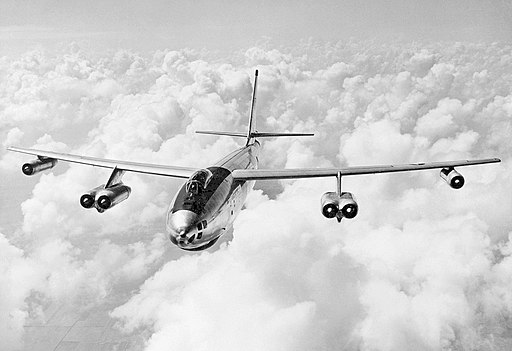The Boeing B-47 Stratojet was a groundbreaking aircraft that made its first flight on this day 75 years ago. It was the United States’ first swept-wing multiengine bomber and represented a major milestone in aviation history. Every large jet aircraft today can trace its roots back to the B-47.

National Nuclear Security Administration / Nevada Site Office, Public domain, via Wikimedia Commons
The B-47’s slender, 35-degree swept-back wings were inspired by German research on the swept wing. George Schairer, Boeing’s chief aerodynamicist, visited a secret German aeronautics laboratory near Braunschweig and saw wind tunnel data on swept-wing jet airplanes. He then sent this information back to the United States, where engineers at the recently completed Boeing High-Speed Wind Tunnel used it to develop and design the XB-47. This model, known as Model 448, featured four TG-180 jet engines in its forward fuselage and two more TG-180s in the rear fuselage. However, the USAAF (United States Army Air Forces) considered the engine installation within the fuselage to be a fire hazard.
In response, Boeing came up with another innovative solution for mounting the engines. They placed the engines in pods (nacelles) suspended under the wings, with two General Electric J-35 engines (GE J-47 engines for all production models) in each pod hanging from the inboard wing and one engine hanging farther out, faired tight beneath the wing. One advantage of podded engines is that they can be mounted closer to the center of gravity of the aircraft, which can improve the aircraft’s stability and handling. Podded engines also allow for better airflow around the engines, which can improve the aircraft’s performance and fuel efficiency. In addition, podded engines can be more easily accessed for maintenance, as they can be removed from the aircraft without requiring significant disassembly.
This arrangement required the use of a tandem bicycle-type landing gear under the front and back sections of the fuselage, as the thin wings provided no space for tricycle main gear to retract. Small outrigger wheels on the inboard engines helped keep the aircraft stable when on the ground. This unique landing gear arrangement dictated some of the B-47’s flying characteristics, as the gear placement meant that the aircraft could not be rotated for takeoff or flared for landing. Instead, it relied on the extended aft gear to provide additional drag for descents.
The resulting Model 450 design was approved by the USAAF in April 1946, and the agency ordered two prototypes, designated as the “XB-47.” The XB-47 prototype made its first flight on December 17, 1947, with test pilots Robert Robbins and Scott Osler at the controls. The flight lasted 27 minutes, taking off from Boeing Field in Seattle and landing at Moses Lake Airfield in central Washington state. The pilots were impressed by the aircraft’s performance.
The B-47 medium bomber became the foundation of the Air Force’s newly created Strategic Air Command, and many of these aircraft were adapted for specialized functions. The basic B-47 design was highly versatile, leading to the development of 38 different variants, ranging from the XB-47A prototype to the standard B-47E bomber, as well as tankers, electronic and photographic reconnaissance models, missile carriers, drones, and weather birds. The B-47 even served in Vietnam as a communications relay aircraft. Some were used as missile carriers, others served as reconnaissance aircraft or trainers, and some carried remote controls for other aircraft. In total, Boeing built 1,373 B-47s, Douglas built 274, and Lockheed built 385, for a total production of 2,032 aircraft. This made the B-47 the most widely produced bomber since World War II.